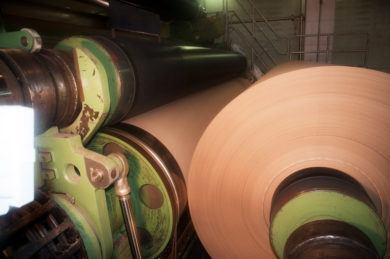We use cardboard in many aspects of modern life, from packaging, shipping, and building to gardening and art. Cardboard is versatile, sturdy, and a great asset to life. However, there is one major setback with cardboard. The production process for creating new cardboard from trees generates a large number of sulfur dioxide emissions. With our environment and ozone already at risk, it is dangerous to produce fresh cardboard for everyday use. Luckily, recycling and reusing cardboard can cut those emissions in half. In this article, we’ll dive into how cardboard is made, and ways to recycle and repurpose cardboard to help you keep the environment in mind with your cardboard use.
Creating Cardboard From Raw Materials
To understand how cardboard is made, take a look at one of the flaps on a cardboard box. You’ll notice the inside and outside of a typical box are made of smooth cardboard pieces, called “liners.” Sandwiched between those two liners is a wavy-looking piece of cardboard called “fluted cardboard.” Fluted cardboard absorbs impact and cushions whatever is inside the box. Together, liners and fluted cardboard make corrugated cardboard, which is often used for shipping and packaging.
The second most common type of cardboard is boxboard. This type of cardboard is most commonly found in the packaging of consumer products like food or health and beauty products. This type of cardboard is thinner than corrugated cardboard and is made from a single sheet.
As we mentioned earlier, cardboard has many uses in our modern world. When we think of cardboard, we often think of corrugated cardboard boxes that are used to package or ship goods. However, cardboard in the form of boxboard is also used to make cereal boxes, paper towels and toilet paper rolls, tissue boxes, and milk or juice cartons. Almost everything that is packaged and shipped uses some sort of cardboard.
What Is Cardboard Made From
What is cardboard made of? The process begins by cutting and lumbering softwood trees. These trees are stripped of bark and turned into wood chips. Any impurities are filtered out using a vibratory screen or air separator like the DE-STONER® Air Classifier for Wood. The wood chips are then reduced to cellulose fibers through a pulping process. These fibers are mixed with water and turned into a slurry, which allows the fibers to separate from natural oils, and a natural glue substance that holds the wood together. Sometimes the fibers are bleached white; if not, they remain a brown color. The fibers are given a final washing to eliminate any contaminants before they are pressed and rolled into paper. These rolls of cardboard paper are converted into boxes or made into different cardboard products.
As you can tell, the process of making cardboard is extensive and poses a threat to the environment. With cardboard being the main product for packaging and shipping items, it is unrealistic to hope that cardboard will just go away. Instead, finding ways to recycle and repurpose cardboard is the best and most realistic solution to helping our environment.
Sorting Cardboard for Recycling
Once a piece of cardboard is thrown into a recycling bin or dropped off at a recycling facility, it is sorted by the recycling company by material type. Depending on where cardboard is recycled, however, the home or property owner may have to sort the recyclables before the recycling program will pick them up.
In many areas, cardboard, glass, plastics, and metals must go into their own separate bins. This is called dual stream recycling. In other areas, though, property owners may only use one recycling bin to collect all recyclables for pickup. This is called single stream recycling. There are pros and cons to both methods of recycling.
When cardboard arrives at a recycling facility via single-stream recycling, it may be sorted and separated using equipment like a rod deck for single stream. In other instances, cardboard that arrives via dual stream recycling is further sorted for contaminants with equipment like the FINGER-SCREEN™ 2.0 Primary Screen. Contaminants like grease and food particles in pizza boxes ruin the quality of paper fibers, so these types of cardboard should be composted or thrown away, not recycled.
Fun fact: Cardboard typically takes 2 months to decompose, so small pieces can be used in a compost heap instead of recycling. To do this, it is recommended to shred the cardboard into the smallest pieces possible to allow for decomposition. The next step would be to soak them all in water, and mix with dirt, fruit peels, grass clippings or manure. This type of compost can be layered with 2 inches of soil between the layers. It’s vital to keep the compost very moist to allow for the best decomposition. Turn the compost every 5-6 days to speed up the process. In a few months the pile will be ready to be used in gardens.
Recycling Cardboard for Reuse
After cardboard is sorted with recycling equipment, they are re-pulped in a process similar to the initial pulping. Cardboard is turned into a slurry to separate and clean the fibers. Fibers are washed to eliminate any contaminants or leftover ink. Finally, the fibers are pressed and rolled into paper, which can be made into more cardboard products. The life cycle of cardboard is extended through recycling and it also decreases the number of trees used in the production — and waste — of cardboard.
One ton of brand-new cardboard requires 3 tons of wood, which is why recycling this material is so important and why General Kinematics is committed to improving our screening and sorting equipment for recycling and waste management of cardboard and other materials. For more information on the life cycle of cardboard or our recycling solutions equipment, contact us today.









